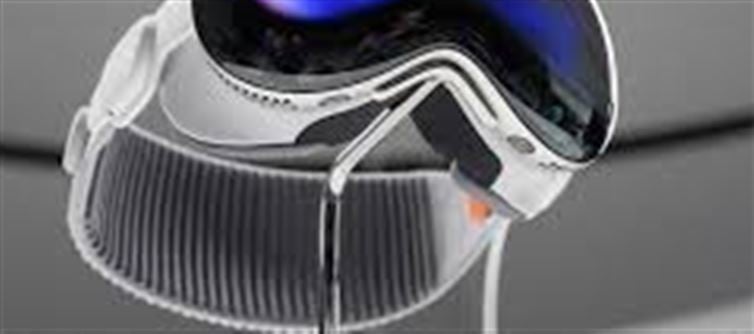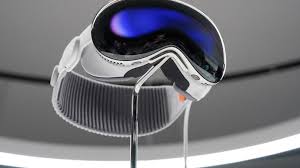
In a surprising move, Apple is reportedly pausing work on its Vision Pro headset to accelerate the development of smart glasses aimed at directly competing with Meta’s AR/VR product lineup. This shift, as per a recent Bloomberg report, signals Apple's strategic pivot in the augmented reality (AR) and virtual reality (VR) space. Here’s what we know about this exciting development.
1. Vision Pro Takes a Backseat to Smart Glasses
· Pause on Vision Pro: Apple’s ambitious Vision Pro headset, which was expected to be a premium AR headset designed for immersive experiences, has been placed on hold.
· Shift in Focus: Instead of continuing with Vision Pro, apple is now directing its resources toward developing smart glasses—a more lightweight, wearable solution.
· Reason for Shift: The Vision Pro headset, priced at over $3,000, faces high costs, complex technology, and uncertain market demand, prompting apple to reassess its strategy.
2. Why Smart Glasses? Competing with Meta’s AR Dominance
· Meta’s AR/VR Lead: With its Meta Quest line and the recently introduced Meta Quest Pro, Meta has established a strong foothold in the AR/VR market.
· Apple’s Strategy: By focusing on smart glasses, apple plans to offer a more accessible alternative to Meta’s products, which may appeal to a broader audience. Smart glasses are lightweight, less intrusive, and can be worn throughout the day.
· Apple’s Vision: The goal seems to be creating a seamless AR experience, allowing users to interact with their environment in new ways without the bulkiness of a traditional headset.
3. Features and Expectations of Apple’s Smart Glasses
· Design: Sleek, minimalistic, and lightweight—Apple’s smart glasses will likely resemble standard eyewear but come with augmented reality functionalities.
· AR Integration: Expect deep integration with iOS and Apple’s broader ecosystem, potentially displaying notifications, navigation, and virtual objects directly on the lenses.
· Enhanced Usability: Unlike the Vision Pro, which is designed for long, immersive experiences, the smart glasses will likely focus on quick, casual interactions—something that’s practical for everyday use.
4. The Timeline: When Will Apple’s Smart Glasses Arrive?
· Current Status: apple is reportedly in the early stages of development for its smart glasses, with an expected release still a few years away.
· Roadmap: industry experts speculate that apple may unveil a prototype in the coming months but a consumer-ready version could take until 2026 or later.
· Competition: As apple ramps up its AR strategy, Meta, Google, and other tech giants are also pushing for dominance in the AR/VR space, creating a fierce competitive landscape.
5. The Long-Term Vision: Apple's AR Future
· Future of AR: Apple's smart glasses are expected to be a part of its broader strategy for augmented reality—a technology that the company believes will be transformative in the next decade.
· Health and Fitness: With Apple’s focus on health and wellness, the smart glasses may integrate features related to fitness tracking, health monitoring, and possibly even eye health.
· Ecosystem Integration: These glasses will likely tie into Apple's wider ecosystem—iPhones, Macs, and iPads—creating a seamless experience across devices.
6. Meta vs. Apple: The AR/VR Battle Heats Up
· Meta’s Investment: Meta has committed heavily to its Metaverse vision, with significant investments in AR/VR technology, including its Quest headsets and Horizon Worlds platform.
· Apple’s Differentiation: While Meta has focused on full immersion, apple aims to create AR glasses that enhance everyday life without the need for a heavy, bulky headset. This could give apple a competitive edge if smart glasses catch on.
· Pricing Strategy: Apple’s smart glasses are expected to be more affordable than the Vision Pro, making them more accessible to the average consumer compared to Meta’s high-end offerings.
7. Implications for the Tech Industry
· Shift in Focus: Apple’s pivot to smart glasses signals a shift in the AR/VR landscape. It indicates that consumers may not yet be ready for heavy-duty AR headsets, but there’s growing demand for more practical, everyday AR applications.
· Industry Impact: This move could drive innovation in the wearable technology space, encouraging other companies to develop more practical and mainstream AR solutions.
· Consumer Adoption: As smart glasses become more integrated into daily life, they could pave the way for AR to become as ubiquitous as smartphones.
Conclusion: Apple’s Strategic Pivot to Smart Glasses
Apple’s decision to focus on smart glasses instead of continuing full-force with the Vision Pro headset is a smart, forward-looking move. By addressing the growing demand for lightweight, wearable technology and competing head-to-head with Meta in the AR space, apple is setting itself up for long-term success in a rapidly evolving market.
Disclaimer:
The views and opinions expressed in this article are those of the author and do not necessarily reflect the official policy or position of any agency, organization, employer, or company. All information provided is for general informational purposes only. While every effort has been made to ensure accuracy, we make no representations or warranties of any kind, express or implied, about the completeness, reliability, or suitability of the information contained herein. Readers are advised to verify facts and seek professional advice where necessary. Any reliance placed on such information is strictly at the reader’s own risk.




 click and follow Indiaherald WhatsApp channel
click and follow Indiaherald WhatsApp channel